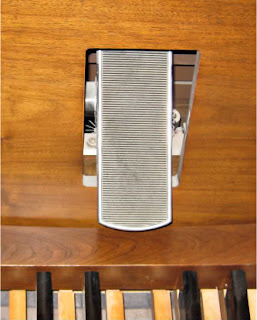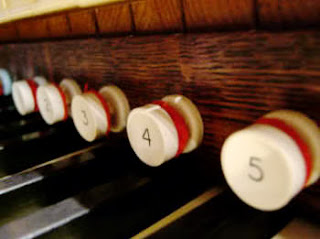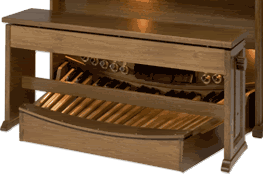Click here for Before We Begin: Acquiring the Essentials
Before we can delve too deeply with our lessons, it's important to know the different parts of the organ.
The Organ Console
The organ console consists of the keyboards, the pedals, and the associated stops of an organ. It is what most of us think of when we picture an organ.

Power Switch
Unlike pianos, organs will not work unless they are turned on.

The location of your power switch may vary, but it is very important to know where it is.
The Manuals
The organ may be best known to the average person for its multiple keyboards.

Generally, the organ in a chapel will be equipped with two keyboards, or manuals. The upper is called the Swell and the lower the Great. If a third manual is present, it is generally called the Choir and added at the bottom, below the Great.
The Pedal Board
The large keyboard along the bottom of the organ is called the pedal board, and is played with the feet.

Pedal boards in the United States generally conform to AGO specifications, consisting of 32 keys arranged in a concave/radiating pattern. This simply means that the outer pedals are slightly higher than the middle pedals (concave) and that the pedals are closer together at the far end than at the end closest to the organ console (radiating).
The lowest note on this pedal board is C two octaves below middle C, also known as C2, to distinguish it from the other Cs on the keyboard. The highest note is G above middle C, also called G4. (Some pedal board end with F4 and only have 30 keys.)
Expression, and Crescendo Pedals
Not to be confused with the pedals of the pedal board, organs also have one or more pedals classified as expression and/or crescendo pedals.
Expression pedals can control the volume of just the swell, individual divisions, or the organ as a whole.
The crescendo pedal incrementally activates stops as it is pressed forward and removes stops as it is depressed backward, starting with the softest stops and ending with the loudest.
When an organ has only one pedal, it generally controls the volume of the entire organ. However, on pipe organs this expression pedal opens and closes the swell box, allowing control over the dynamics of just the swell division.

When an electric organ has two pedals, they are usually expression pedals, with the one on the left controlling the volume of the swell manual and the one on the right the volume of the great and pedal. However, sometimes one pedal controls the volume of the entire organ and the other is a crescendo pedal. Generally speaking, when a third pedal is added, it is to the right of the expression pedals and is a crescendo pedal.

You may need to experiment on your organ to identify the function of your pedals.
Stops and Couplers
I discussed stops a bit in the Before We Begin: Acquiring the Essentials post. Stops are the tabs, rocker tabs, or drawknobs on the organ that have numbers and names on or above them. They are divided into sections that correspond with each keyboard, perhaps with an additional General section, and are located either above the manuals and/or in stop jambs on both sides of the manuals.

Each manual or pedal usually controls a separate division of the instrument with its own stops. Through couplers, keyboards can play stops from different divisions of the organ. The couplers you will most likely see on your organ are Swell to Great, Great to Pedal, Swell to Pedal, Bass Coupler, Melody Coupler, and possibly one or more Octave Couplers (such as Swell to Swell 4').
Couplers are fairly self-explanatory. If you select "Swell to Great," any stop that you have selected on the Swell will play on the Great. If you have both "Swell to Pedal" and "Great to Pedal" selected, all of the stops selected on the Swell and Great will also be played on the Pedal, in addition to any of the Pedal stops selected.
The Bass Coupler and Melody Coupler are related. The Bass Coupler adds the selected pedal stops to the lowest note currently being played on the Great. It's a "cheater's way" of achieving a full organ sound without use of the pedals. The Melody Coupler adds the selected Swell stops to the highest note being played on the Great, accentuating the melody of the piece being played. This can be a good way to help the congregation hear the melody when they're singing an unfamiliar hymn, or to help add interest to prelude or postlude music.
Octave couplers work within a manual to double the stops up or down one or more octaves. For example, if you have one 8' Swell stop selected, select "Swell to Swell 4'" or "Octave Coupler," and play middle C on the Swell, it will sound as though middle C and the C one octave up are being played at the same time. If you instead select "Swell to Swell 16'", if will sound as if middle C and the C one octave down are being played at the same time. (We'll explain 4', 8', and 16' in the next lesson.)
As I mentioned, stops will be explained in detail in the next two lessons, but here's a quick overview. In a pipe organ, a rank is a row of pipes in one tone color, with one pipe dedicated to each key. Each stop turns a rank of pipes on or off. In electric organs, each stop selects a certain sound based on a pipe organ's rank of pipes.
Pistons and Combination Action
Pistons are part of the combination action system, which allows the organist to capture certain registrations and recall them instantly through the thumb pistons or toe studs.

Some organs only have general pistons, which remember information for the entire organ. Others have general and divisional pistons, so that additionally a keyboard or division can be programmed independently of the others.

Most organs have both preset and programmable pistons, and some of the couplers are conveniently repeated as pistons or toe studs. Many even have a "Cancel" piston that removes every stop that has been selected on the organ, which allows for faster manual registration changes. A "Tutti" piston functions like a crescendo pedal that is all the way down--selecting practically every stop of the organ.
Newer organs have multiple levels of memory, which allow each piston to be programmed more than once so that each organist has access to his/her own unique memory.
Bench
The organ bench is an essential component of the organ. The best benches are adjustable. Some have a knob that turns to raise and lower the bench. Others have removable and flippable blocks that can be adjusted for three separate heights. There are other adjustable options as well.

In conclusion
Please take the time to familiarize yourself with your organ. If you have any questions about components that I haven't covered here, please let me know. After you are familiar with all of these components and how they relate to your organ, continue on to Lesson 2: Demystifying the Organ Stops, Part 1.




is it allowable to play foot pedals also while using the bass coupler
ReplyDeleteThe bass coupler works by taking the lowest played note on the Great, and coupling the pedal stops to it. After a certain note, near middle C, it stops pulling the pedal registration. So if you are playing a hymn in the manuals, the hope is that the bass coupler will make it sound like the bass is being played in the pedals.
DeleteGenerally speaking, there is no need to use the bass coupler while also playing the pedalboard. Since the left hand should not be doubling the bass when the feet are playing it, using the bass coupler might pull the tenor note down and muddy the sound.
On my home organ, using the bass coupler actually turns off the pedalboard.
I hope this answers your question! If you are not playing the bass part in the pedals, but something else, let me know and I can answer any specific questions you might have.
Thanks for reading!
me again. I have practiced with playing the two together and with specific stops set, the sound is great
ReplyDeleteThere may be times when it works. I'm curious to hear how and what you did.
DeleteSo is it acceptable to just play the great keys on the manual and not play the pedal board? I'm filling in at church today and the pedals are stressing me out.
ReplyDeleteYes, most new organists don't use the pedals, or use them in a very limited capacity. Many organs have something called a bass coupler, which will take the pedal stops and add them to the lowest note played by the right hand.
DeleteGood luck, today!
Sorry--that should say lowest note played by the LEFT hand.
DeleteI'm a. one foot bass pedal player, but I'm scheduled to play a piece that has a harder bassline. This will be done on a pipe organ and not the electronic organ I am familiar with. Do traditional pipe organs even have a base coupler? I would assume it is a computerized thing
DeleteAbout the monarke(monarche) organ, what is that white buttons in the left and right side of an organ? is that something that also add volume to the organ?
ReplyDeleteI'm not sure which model you are referencing. http://www.johannus.com/en-us/collection/home-organs/monarke-home-organs
DeleteHi,
ReplyDeleteThank you for your informative articles! Do you happen to have any references that speak specifically about old Conn organs? I was just given one, and am excited to learn about this model.
Thank you
What specifically makes a draggy muddy sound when beginning organists use the bass coupler?
ReplyDeleteThe bass coupler typically takes the lowest note the hands are playing and applies the pedal registration to that note. A muddy sound could be because the coupler is applying that registration to all notes below a certain point, such as middle C; the pedal registration isn't balanced with the manual registration; or the notes aren't being played at the same time, so the coupler is jumping between playing the bass note, the tenor note, or sometimes the alto note. Do any of these options sound like the culprit?
DeleteYet some stakes in Nigeria aren't delivered organs because of segregation or something. And no one can do anything about it. It hurts!
ReplyDeletePicture a stake centre of thousands of members managing an e353 piano.
I'll keep posting this until it gets to the general authority in charge of whatever this should be called
I'm having to sub on organ a lot in my ward, but I'm not very experienced it in yet. Is there a way to leave the base coupler on and turn the pedals off? If I turn the pedal switches off it seems to take away the effect of the base coupler, but I'm straining my legs trying to figure out where to put them without touching the pedals.
ReplyDeleteThe way the bass coupler works, is that it takes whatever your pedal registration is, and applies it to the bottom note your hands play. On most organs, there's no way to turn the pedals off and still utilize the bass coupler.
DeleteThere are a few places to rest your feet. If you wear shoes with a slight heel, you can hook them over the bar that runs under the bench. This is the most common place to have one or both of them when they're not playing.
Alternatively, you can rest one or both of your feet on the expression pedal(s), being careful not to bump the crescendo pedal by mistake.
If necessary, you also might be able to rest your toes on the wood apron at the end of the pedals, provided you don't have toe studs in the way.
You could always figure out what the tonic and dominant notes are for the hymn, and rest your feet over those pedals, playing them when it's appropriate.
Good luck! I hope this helps.
Mechanically speaking, how do the manual couplers work?
ReplyDelete